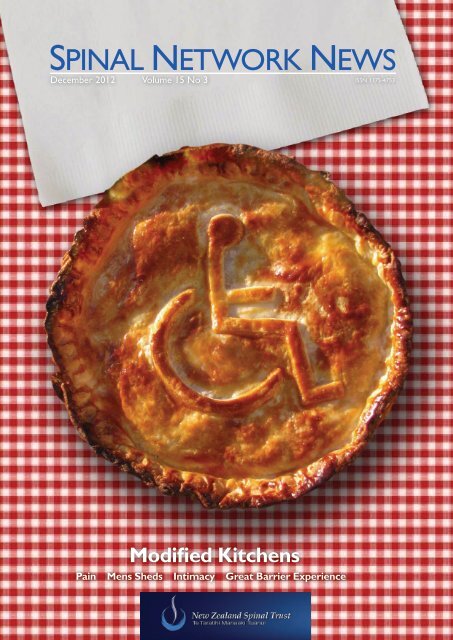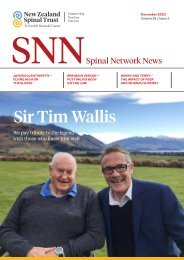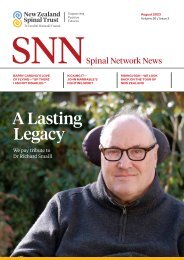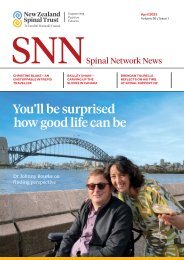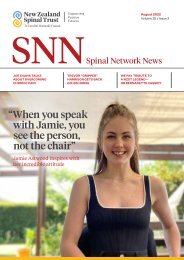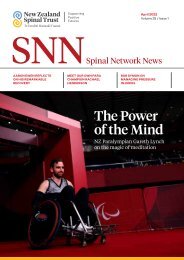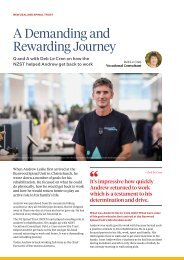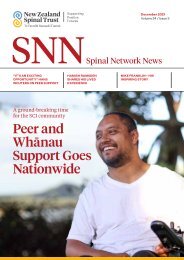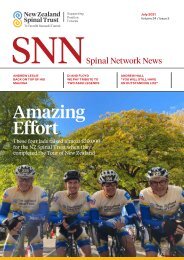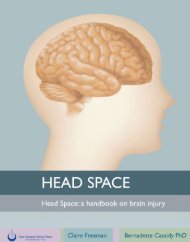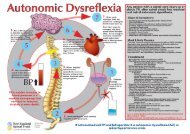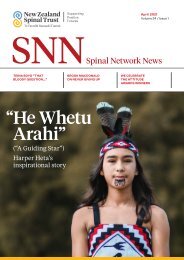SNN December 2012
Pain Men’s Sheds Intimacy Great Barrier Experience
Pain
Men’s Sheds
Intimacy
Great Barrier Experience
Create successful ePaper yourself
Turn your PDF publications into a flip-book with our unique Google optimized e-Paper software.
SPINAL NETWORK NEWS<br />
<strong>December</strong> <strong>2012</strong> Volume 15 No 3 ISSN 1175-4753<br />
Modified Kitchens<br />
Pain Mens Sheds Intimacy Great Barrier Experience
CONTENTS<br />
1 CEO Report<br />
2 Modify Your Kitchen<br />
EDITORIAL TEAM<br />
TRUDY MULLIGAN<br />
Hi, my name is Trudy Mulligan and I’m one of the design<br />
team at the NZ Spinal Trust. I’ve been a wheelchair user<br />
for around 15 years though my transition to full paraplegic<br />
took a decade. I studied at the Canterbury School of Fine<br />
Arts majoring in design. I have had my own design business<br />
for 16 years. I’m employed by the NZ Spinal Trust as design<br />
consultant and I thoroughly enjoy working as a member of<br />
the superb design team.<br />
6 Mr Bill Utley<br />
7 QEII Track<br />
8 Pain<br />
14 Mt John Observatory<br />
17 Maternal Instincts<br />
18 NZST Programmes<br />
22 The Samoan Spinal Network<br />
CLAIRE FREEMAN<br />
JOHN BOURKE<br />
Hi, my name is Claire Freeman and I am part of this fantastic<br />
team of fellow writers and researchers for the Network News.<br />
I am employed full time by the Canterbury District Health<br />
Board as a graphic designer, and I also work for the NZ Spinal<br />
Trust. I am finishing off my Masters in Health Science, Otago<br />
University and plan on pursuing more study. I enjoy thinking<br />
about long walks on the beach and am not an alcoholic but do<br />
like bloody marys without the tabasco sauce- cheers.<br />
Hello! After experiencing a C4/5 SCI in 2005, and spending<br />
several years in Nelson, I am currently based in Christchurch<br />
with my wife Corrin. Working with Paul and the team at the<br />
Spinal Network News is great, and I have found it to be a<br />
fantastic way to keep in touch with the various happenings in<br />
the New Zealand SCI community. I am currently completing a<br />
Post Grad Diploma in Rehabilitation through Otago University,<br />
and in <strong>2012</strong> I hope to complete a Masters thesis exploring<br />
issues facing those with high-level SCI following injury.<br />
CONTRIBUTING<br />
WRITERS<br />
Ben Lucas<br />
Bernadette Cassidy<br />
Cindy Allison<br />
Carolynn Day<br />
Trudy Mulligan<br />
Claire Freeman<br />
Debz Mitchell<br />
John Bourke<br />
Hi, my name is Bernadette Cassidy and I am delighted to be<br />
part of the Spinal Networks News Editorial Team. I have been<br />
with the New Zealand Spinal Trust as Library and Design Team<br />
Manager for nearly 10 years and have seen the organisation<br />
grow from strength to strength. I am passionate about the<br />
work we do at the Trust and how libraries can assist in reaching<br />
disadvantaged groups - having access to quality and timely<br />
information empowers people ‘to reshape their lives’ and assist<br />
BERNADETTE CASSIDY with reintegration back into their communities.<br />
SPINAL NETWORK NEWS is published by the NZ Spinal Trust<br />
Send your contributions to:<br />
The Editor SPINAL NETWORK NEWS<br />
c/- New Zealand Spinal Trust, Private Bag 4708, Christchurch 8140<br />
Tel: (03) 383 7540 , Fax: (03) 383 7500<br />
Email:<br />
Web: www.nzspinaltrust.org.nz<br />
DISCLAIMER:<br />
The views expressed in SPINAL NETWORK NEWS are those<br />
of its contributors. They do not necessarily represent the opinion<br />
of the members of the Editorial Committee or the policies of<br />
the New Zealand Spinal Trust.<br />
DESIGN & LAYOUT: Trudy Mulligan, Designer NZ Spinal Trust<br />
PRINTER: The Caxton Press
CEO Report<br />
Well, who can believe that <strong>2012</strong> is almost over and<br />
Christmas is just around the corner? Personally I have<br />
only just got used to putting <strong>2012</strong> instead of 2011…<br />
<strong>2012</strong> has been an eventful year for the Trust with a lot<br />
taking place throughout the year;<br />
In February we were given short notice to vacate the<br />
Allan Bean Centre (ABC), due to a couple of walls which<br />
were deemed unsafe, putting our Team at risk in the<br />
event of any future earthquake. I cannot speak highly<br />
enough of the Canterbury District Health Board (CDHB),<br />
and Burwood Hospital as we were quickly relocated<br />
within Burwood Hospital when space within CDHB<br />
was incredibly tight, especially admin space. With a little<br />
juggling around, we managed to move all that we needed<br />
and set up with no disruption to our services. After<br />
two months, we moved back into the ABC. Making the<br />
building safe was a direct expense to CDHB and they<br />
didn’t need to complete these repairs when there was<br />
so much else going on, so a huge thank you to all the<br />
management at Burwood Hospital and CDHB for doing<br />
this for us.<br />
In August of this year, we managed to gain access to the<br />
QEII Athletics Track, thanks to the Christchurch City<br />
Council. A team of us tore the track up and mounted<br />
100 samples onto board and more importantly, got some<br />
iconic pieces of the track relating to Dick Tayler who won<br />
the 10,000m event at the 1974 Commonwealth Games,<br />
as well as John Walker, one of NZ’s greatest runners. The<br />
pieces were auctioned on Trade Me in August which raised<br />
valuable funds for the Trust<br />
We were also the Official Charity for the recent<br />
Benchmark Homes Festival of Cycling – an iconic two<br />
day cycle event in Christchurch. We had a wheelchair<br />
race with celebrities as well as a handcycle event. Again,<br />
the exposure was invaluable as well as the fact that we<br />
managed to raise more funds for the Trust.<br />
Other fundraising events were the Christchurch Marathon<br />
and Kim Allan, who ran non-stop for 480km, raising funds<br />
for the Trust.<br />
Our Team here at the Trust continues to be highly<br />
dedicated and focused on the best outcomes for you as<br />
the end user. I am continually impressed by how our Team<br />
never need to be reminded that you as the end user are<br />
the most important person in relation to the Trust and<br />
the work we do.<br />
Funding has been tight in the not-for-profit sector and due<br />
to the fantastic legacy left by those who have gone before<br />
me, the Trust has positioned itself as a highly respected,<br />
quality and trusted organisation that provides services<br />
that are recognised as important in the Spinal Community.<br />
As a result of this, we have managed to not only keep<br />
functioning, but grow some of our services.<br />
2013 is just around the corner and we’re looking forward<br />
to another exciting year. I wish you all a safe and happy<br />
Christmas and look forward to the New Year and the<br />
opportunity and excitement that it brings.<br />
Ben Lucas<br />
The Mayor of Christchurch, Bob Parker wrote a book,<br />
‘Ripped Apart; a city in chaos’ which was released in<br />
November, with the launch being held here in the Allan<br />
Bean Centre Library. He is donating the royalties from<br />
the book to our Connecting People programme. At the<br />
time of printing, the amount isn’t available, but for the<br />
NZST to have national exposure was invaluable. Mayor<br />
Parker’s books are available in most bookshops as well as<br />
directly from the Trust.<br />
1
Modify<br />
your<br />
Kitchen?<br />
When my wife’s away and i have to fend for myself, I’m<br />
constantly reminded of how wheelchair-unfriendly our<br />
kitchen is. I can’t safely reach the back of the cook-top,<br />
I can’t get at the sink properly to wash up, i can’t reach<br />
some of the cupboards (including The one where the<br />
cook books are – which is probably a blessing anyway), I<br />
can’t get vital stuff from the back of the fridge – especially<br />
on the lower shelves. There’s got to be a better way!<br />
However, I have to admit that my wife uses the kitchen<br />
much more than I do which of course creates further<br />
problems, because the kitchen really has to suit both our<br />
needs. Bench heights, along with sink and cook-top heights<br />
would especially make problems for one or other of us.<br />
So I’ve been exploring the internet for ways in which<br />
kitchens could be made more useful for me, with a few<br />
additional thoughts on how we could make the space<br />
more suitable for both of us. First of all, what would I<br />
like?<br />
Most of all, I think, I’d like to be able to get my knees<br />
underneath the cook-top, so I can get much closer to pots<br />
and pans heating on there. It would also be a heck of a<br />
lot safer than trying to juggle things from a low, sideways<br />
position. The other thing that would be neat would be to<br />
get my knees right under the sink, so that I can properly<br />
reach in there to wash the dishes. It would be helpful, too,<br />
to be able to reach the stuff in the higher cupboards, and<br />
especially to be able to get at the food in the back of the<br />
bottom shelves of the fridge. Anything else while we’re<br />
about it? Well, yes, there is. Wouldn’t it be nice to be able<br />
to put food easily into – and take hot things out of - the<br />
oven without having to reach out round that great big<br />
downward-opening door? And maybe those benches are a<br />
little too high for comfort?<br />
So let’s see what Google can do for us. Well, if you live<br />
in Sweden, the USA or the UK and have some money,<br />
you could buy the perfect kitchen. YouTube gives several<br />
examples. I picked up a few good ideas there – side-opening<br />
oven doors, slide out cupboard shelves, lift-racks that lower<br />
shelves in higher cupboards down to my level, slide-out<br />
chopping board, height-adjustable benches, cook-tops and<br />
even sinks. Controls at the front of the cook top would be<br />
useful too – it reduces the chances of my sleeves catching in<br />
pot handles as i reach across above them.<br />
Of course there are drawbacks. If you’ve got knee space<br />
under the cook-top and under the sink, where, exactly,<br />
are you going to put the pots and pans that live under the<br />
cook-top and the scungy cleaning pads and horrid things<br />
that invariably live under the sink? Well, one good idea I<br />
2
came across was cupboards on casters that could, be<br />
moved out of those places. The under-sink plumbing<br />
might need to be rearranged for that to work, though. In<br />
addition, the sink itself might need to be a shallower one<br />
than usual.<br />
The only way in which the kitchen could be organised for<br />
people of two different heights would be to have cooktop,<br />
sink unit and perhaps benchtops to be adjustable for<br />
height. This could be done either by manual crank handles,<br />
or, as American kitchen designers tend to suggest, using<br />
push button electric motors.<br />
One thing I have to stress is, as i was told in my very early<br />
days in Burwood, that we’re all different. I’m a T3 para<br />
who buggered his left rotator cuff whilst doing a transfer<br />
8 years ago, so I’m now in a power chair. So I’ve been<br />
describing what would suit me. But some of the ideas I’ve<br />
suggested would suit many, but not all, others.<br />
Ian Popay<br />
Useful internet addresses for<br />
wheelchair kitchens<br />
Development of Kitchen Models for Wheelchair Users.<br />
http://www.idemployee.id.tue.nl/g.w.m.rauterberg/conferences/<br />
cd_donotopen/adc/final_paper/031.pdf.<br />
1,653 wheelchair accessible Kitchen Design Photos.<br />
http://www.houzz.com/photos/kitchen/wheelchair-accessible.<br />
Useful tips from the Canadian Paraplegic Association, at<br />
http://www.thespine.ca/articles/accessible_renovations/design_<br />
wheelchair_accessible_kitchen/<br />
Kitchen Design. From Independent Living, UK<br />
http://www.independentliving.co.uk/kitchen-design.html<br />
If you’ve just won Lotto, here’s a futurist kitchen design at<br />
http://www.universaldesignstyle.com/liberty-project-accessiblekitchen-by-whirlpool-latin-america/.<br />
See the amazing and innovative variations of the Sky-Lab<br />
Italian kitchen design<br />
http://www.snaidero.it/<br />
(two pictures to the left)<br />
3
In 2011, I finished my Masters thesis from Otago University<br />
Health Sciences Department, titled ‘Experiences of Intimacy<br />
and Relationship Maintenance in Acute Spinal Cord Injury<br />
Rehabilitation: An Interpretative Phenomenological Analysis’. It<br />
was a part time project I slipped in to my crazy life and although<br />
I was told it would be like trudging through setting concrete, I<br />
loved it. I found the whole process fascinating and learnt a great<br />
deal, both educationally and within myself. I found that during the<br />
interviews, I unwittingly confronted my own demons as feelings of<br />
grief and repressed trauma surfaced.<br />
In simple terms, the thesis was an exploration of the coupled<br />
perspective as they journey through the hospital directly after<br />
one of them has had a spinal cord injury. Couples talked<br />
about the problems they had with a loss of autonomy,<br />
feelings of intense grief and guilt, not being acknowledged<br />
as a couple, and all were curious about what the future<br />
would be like. Another interesting point all the couples<br />
made was that they felt closer to their partner as a result<br />
of the injury. They agreed open communication was vital<br />
to a healthy relationship, and I felt a real sense of teamwork<br />
between the partners.<br />
They spoke about a few health professionals at Burwood who<br />
had made their time in the spinal unit a lot easier. Relationship<br />
maintenance and intimacy was addressed by a<br />
Intimacy<br />
specialist nurse who all felt was fantastic and extremely helpful,<br />
however, couples also spoke about situations where they felt<br />
disrespected by health professionals and this caused both in<br />
the relationship a great deal of grief. A lack of privacy and<br />
space was a constant problem for couples who struggled<br />
with living with curtains for walls and no place to go to share<br />
intimate moments together.<br />
Since completing the thesis, I’ve been keen to educate as<br />
many people of (with?) my results. I was lucky enough to<br />
present recently at the Australia New Zealand Spinal Cord<br />
Society (ANZCoS) in Melbourne, helped by funding from the<br />
NZST and BAIL. The presentation went really well and the<br />
feedback I received was encouraging which made the trip very<br />
worthwhile. I also came back with pop-eye sized arm muscles<br />
as I discovered (and trudged around) Melbournes inner city<br />
hills.<br />
The last step in this journey is to write a handbook to help<br />
people with SCI and their families. Although the handbook<br />
‘Back on Track’ has been extremely well received, there<br />
is more of a focus towards medically related issues. The<br />
handbook I’m compiling will address many holistic issues that<br />
affect people such as relationship maintenance, intimacy issues<br />
and grief. It is hoped the book will be ready for print in a years<br />
time.<br />
Claire Freeman<br />
4
5
Where the Stairway to<br />
Heaven Begins<br />
by Trent Mabbett<br />
Inclusive education in Kyrgyzstan<br />
Cheryl and I scored a gig in<br />
Kyrgyzstan, Central Asia. I work<br />
in a NZ Polytechnic in curriculum<br />
development (helping to develop<br />
courses of study). A former colleague<br />
told me of a contract in Kyrgyzstan<br />
for 3 weeks helping to make courses<br />
there more accessible to people with<br />
disabilities. Applying for the contract,<br />
I got it on the basis of my experience<br />
in curriculum development and my<br />
experience with disability (I’m a C6<br />
Tetraplegic). Realising I needed help to<br />
bring inclusive education to Kyrgyzstan<br />
(its more than a one person<br />
job), I dragged Cheryl (caregiver,<br />
photojournalist and diplomat) along<br />
with me.<br />
The Miracle<br />
We got there and back in two pieces!<br />
We flew on Air New Zealand to<br />
Auckland, then China Southern Airlines<br />
to Guangzhou, again to Urumqi, and<br />
again to Bishkek. Forty seven hours<br />
to get there and 36 hours to get back<br />
(including stops at airports). Definitely<br />
not for the fainthearted, the impatient<br />
or for the easily frustrated, or large of<br />
stature. Actually, only for the lunatics.<br />
We figured the average age of the<br />
employees at the Chinese airports<br />
was about 17, unfortunately at this age<br />
they don’t seem to have any clues or<br />
authority and it was a struggle getting<br />
sensible help. Fortunately, we got<br />
upgraded to Premier economy on the<br />
longer flights. For some reason their<br />
planes won’t allow the armrest at the<br />
end of, or between, the seats to lift up,<br />
so that it is very difficult to transfer<br />
into the seats and if you do manage to<br />
score an empty seat next to you, you<br />
can’t lie down.<br />
The Kyrgyz…<br />
Decent people- not greet people in<br />
the street people, but they could be<br />
affectionate (1060814). Their history<br />
is an on-going intersection between<br />
globalisation and nomads. Like a cross<br />
between the Hungarians and the<br />
Mongols.<br />
-poverty poor- but the people are<br />
somewhat cared for (a Socialist relic<br />
of the Soviet Union). It is safe enough<br />
wandering around still.<br />
…and their dirt<br />
The farthest anybody can get from<br />
the ocean and surrounded by dodgy<br />
neighbours. Monumental mountains<br />
(1060638), rivers and lakes, just like the<br />
Southern Alps and steeped steppes. As<br />
for animals there were sheep, horses<br />
(106706) and crows, crows, crows.<br />
Steps of the steppes, steeped in<br />
monuments<br />
There seems to be some deeprooted<br />
cultural prevalence for steps.<br />
A ‘Stairway to heaven’ propensity of<br />
the people. It is said that at the top of<br />
Mount Kyrgyzstan is one last pile of<br />
steps to climb. The Kyrgyz also love<br />
monuments (or their rulers do): their<br />
sheer numbers fall short of the steps,<br />
but their monumentalism surpasses<br />
them. They consist of Soviet heroes<br />
and past dictators; to the war, the<br />
other war, and all the other wars too;<br />
to dictators and revolutions, past<br />
6
traumas and triumphs; creating a history and an identity<br />
for the nation (an identity of revolt).<br />
Where the money from the tin buried under<br />
Angela Merkel’s mattress is going<br />
My part of the contract was to adapt the curriculum of<br />
three courses at three different adult education centres to<br />
be more inclusive to people with disabilities. It is part of<br />
a larger project for a French organisation called Handicap<br />
International that seeks to steamroll inclusive curriculums<br />
across the Kyrgyzstan education system, flattening all<br />
steps in the way. Their part of the contract was to get us<br />
there, stuff us full of food and get us back home alive. The<br />
funding all comes from the European taxpayers. We had<br />
three workshops (IMG 1031 & 1081). One to choose the<br />
jobs to train people for (we chose cooking, seamstress<br />
and appliance repair), one to work out the method to<br />
adapt the curriculum and a final one for the hell of it.<br />
When I returned to New Zealand I had to submit a<br />
report explaining how I had spent Angela’s savings and<br />
how those steps would be steamrolled before their eyes.<br />
The moral of the story<br />
You never know where jobs and contacts will lead. My<br />
advice is to take all opportunities etc… as travel is<br />
exhilarating. But even if travel is not possible we now<br />
have access to the whole world through innovations in<br />
technology and media. The steps are there to stay. But the<br />
fight to flatten them continues.<br />
The plea<br />
Please send any photos, video etc. of you (or somebody<br />
with a disability) who is engaged in adult education to<br />
me at my email address trent@actrix.co.nz. I promised<br />
the Kyrgyz teachers I would send them to show them<br />
inclusion in action, but visual evidence of inclusive adult<br />
education in NZ is hard to find- I’m persevering thoughanything<br />
we can do to promote people with disabilities<br />
being productive is worthwhile.<br />
An on-going<br />
intersection between<br />
globalisation and<br />
nomads.<br />
7
Pain Management Centre<br />
Burwood Hospital<br />
Background<br />
The prevention and management of pain is a significant<br />
aspect of health care. There is increasing acknowledgement<br />
that pain, particularly persistent pain, is a multidimensional<br />
experience which requires a comprehensive, integrated and<br />
multifaceted model of care.<br />
Introduction<br />
Based at the Burwood Hospital site, the Pain Management<br />
Centre (PMC) provides a coordinated interdisciplinary<br />
service that is customised to meet the complex needs of<br />
individuals with persistent chronic pain.<br />
This service is one of only two recognised Interdisciplinary<br />
Pain Management Centres in New Zealand, the other<br />
is situated in Auckland. Smaller pain clinics/ services are<br />
situated around the country.<br />
The co-ordinated interdisciplinary service provides<br />
outpatient clinics and programmes; interventional<br />
procedures and occasional inpatient admissions.<br />
Referral to the service is predominantly via the GP, ACC<br />
case managers or by medical specialists. These are triaged<br />
and prioritised according to accepted criteria.<br />
The PMC team comprises of a wide range of health<br />
disciplines with extensive knowledge and experience in the<br />
assessment and treatment of persistent pain conditions.<br />
The coordinated approach encompasses the biopsychosocial<br />
approach to persistent / chronic pain. This<br />
approach recognises the complex nature of persistent pain<br />
and endorses the promotion of independence and self<br />
management for people experiencing this.<br />
Location<br />
The PMC service is currently housed in two settings.<br />
The service occupies space in the old Nurses Hostel at<br />
Burwood and the associated procedure clinic utilises two<br />
converted rooms in the main hospital near the Birthing<br />
Unit. Some patient procedures are also carried out in the<br />
Burwood operating suite.<br />
Current Services<br />
Initial assessment will routinely be via a Comprehensive<br />
Pain Assessment (CPA), which is carried out by members of<br />
the inter-disciplinary team. The CPA takes place over 3-4<br />
hours, with three assessment sessions looking at a range<br />
of aspects. The assessment team then meets to discuss<br />
and a team member will feedback the recommendations<br />
to the person being assessed (immediately following this).<br />
A report of the Comprehensive Pain Assessment is then<br />
prepared and sent out.<br />
If the person is being seen under ACC funding, then their<br />
ACC Case Manager will consider approval of the team’s<br />
recommendations and referral to the services indicated.<br />
If the person is being seen under Ministry of Health funding<br />
then referral to other services is made along with provision<br />
of services by the PMC team as indicated. These services<br />
may include (but not be limited to):<br />
• Medical, nursing or allied health follow-up appointments<br />
Medical procedures<br />
outpatient interdisciplinary programmes including:<br />
“Activity Focused” programmes- range in duration and<br />
include health professionals from various disciplines (as<br />
indicated)<br />
a comprehensive 3 week inter-disciplinary group<br />
programme (CHOICES )<br />
The PMC team currently includes medical specialists,<br />
nurses, occupational therapists, physiotherapists, clinical<br />
psychologists, social worker, clerical staff, clinical coordinator<br />
and a service manager.<br />
The team work together, with a focus on assisting the<br />
person with persistent pain to optimise engagement in<br />
valued activities, quality of life and independence/ self<br />
management.<br />
8
Pain research continues in many directions. Studies show<br />
that certain practices may have not just a psychological<br />
response but a also a physiological one. Distraction,<br />
meditation and aggression all may be ways to increase<br />
tolerance to pain.<br />
Research released on 07 September <strong>2012</strong> by Keele University<br />
demonstrates that playing a violent video game and entering<br />
the virtual world can give people a better tolerance for pain.<br />
The study of 40 volunteers found that playing violent ‘first<br />
person shooter’ games, in which a player kills enemies in a<br />
virtual environment, enabled participants to tolerate an ice<br />
water pain challenge for longer than if they had played a<br />
non-violent golf game. On average, participants kept their<br />
hands in the icy water for 65 per cent longer after playing the<br />
violent game, indicating that playing the game increased the<br />
participants’ pain tolerance. Heart rate was also shown to<br />
increase.<br />
The researchers suggest the increased pain tolerance and<br />
heart rate can be attributed to the body’s natural ‘fight or<br />
flight’ response to stress, which can activate descending pain<br />
inhibitory pathways in the brain reducing sensitivity to pain.<br />
The study was prompted following research by the same Keele<br />
University team showing that swearing increases people’s<br />
tolerance for pain. Senior lecturer in psychology at Keele<br />
University, Dr Richard Stephens, a who led the study, said: “We<br />
assumed that swearing eases pain by sparking an emotional<br />
reaction in participants – most likely to be aggression – in<br />
turn setting off the body’s fight or flight response. This latest<br />
study was a test of that assumption in which we set out to<br />
try and raise participants’ aggression levels by having them<br />
play a violent video game. We then tested the effect on pain<br />
tolerance. The results confirm our predictions that playing<br />
the video game increased both feelings of aggression and pain<br />
tolerance”.<br />
Intriguingly, the new study suggests that playing violent video<br />
games may be a good way to cope with pain, at least in the<br />
short term. Dr Stephens continued: “Pain researchers have<br />
already been exploring the use of virtual reality as a way of<br />
helping people better deal with pain. A group in Seattle, USA<br />
encouraged children with severe burns to explore a snowy<br />
virtual landscape while their dressings were changed. This<br />
reduced the amount of pain and discomfort they felt during this<br />
procedure”.<br />
The results have been published in the journal Psychological<br />
Reports, which specialises in empirical, theoretical, mainstream,<br />
and alternative views on issues in psychology.<br />
online from: The Huffington Post UK<br />
Mental distraction really can reduce pain, and<br />
the effect is not just in the mind, research has shown.<br />
Scientists carried out scanning studies which showed how a<br />
distracting memory test blocked incoming pain signals.<br />
Volunteers were asked to complete either a hard or easy<br />
letter memory task while having a painful level of heat<br />
applied to their arms. While distracted by the harder task,<br />
they perceived less pain. This was reflected by lower activity<br />
in the spinal cord which could be seen in the functional<br />
magnetic resonance imaging (fMRI) scans.<br />
“The results demonstrate that this phenomenon is not<br />
just a psychological phenomenon, but an active neuronal<br />
mechanism reducing the amount of pain signals ascending<br />
from the spinal cord to higher-order brain regions,” said<br />
study leader Dr Christian Sprenger, from the University<br />
Medical Centre Hamburg-Eppendorf in Germany.<br />
The findings are reported online in the journal Current Biology.<br />
9
A Spinal Cord<br />
Stimulator<br />
In the last edition of the Spinal Network News I wrote about<br />
the types of pain I have experienced since sustaining a SCI in<br />
November 2006. Since writing that article I have had a spinal<br />
cord stimulator (SCS) placed in an attempt to reduce muscle<br />
spasticity and pain in my lower trunk and legs. This device<br />
provides a neuromodulation effect and, while the use of this<br />
device for the treatment of spasticity is somewhat novel,<br />
it is commonly used for chronic pain disorders including<br />
some types of neuropathic pain and complex regional pain<br />
syndrome.<br />
For various reasons I identified that I needed to withdraw and<br />
come off the oral baclofen that I take to control my high tone<br />
and spasticity. In-depth discussions about different treatment<br />
options for my spasticity with Dr Rick Acland (spinal cord<br />
injury and pain management consultant) from the Burwood<br />
hospital and Mr Martin MacFarlane (neurosurgeon) from<br />
Christchurch hospital narrowed the possibilities down to<br />
either an intrathecal baclofen pump or the SCS. The decision<br />
to have spinal surgery and commit myself to a hospital stay,<br />
temporarily reduced independence and further rehabilitation<br />
was something I thought carefully about and was not a<br />
decision I made lightly! Weighing up the pros and cons of the<br />
two options I decided to try the SCS. On the 18th September<br />
<strong>2012</strong> I had surgery to place the device which was done<br />
under a combination of spinal and general anaesthesia. The<br />
SCS consists of a plate of stimulating electrodes (implanted<br />
in the epidural space at the level of T11), an electrical pulse<br />
generator (implanted under the skin in the lower abdominal<br />
area) and conducting wires connecting the electrode plate<br />
to the generator (placed beneath the skin). There is also a<br />
generator remote control for programming and control of<br />
the device.<br />
Thanks to the talented team of Dr Acland, Mr MacFarlane and<br />
their colleagues, the surgery went well and my hospital stay<br />
was as pleasant as possible. Two and a half months down the<br />
track I’m utilising the device daily and experiencing what it<br />
has to offer me. It is highly programmable in that each of the<br />
16 small electrodes on the plate can be recruited individually,<br />
or together, and along with the ability to vary the voltage,<br />
amplitude and pulse width there is an almost infinite number<br />
of different programmes to be discovered. With the help<br />
of Michelle Walker (Burwood pain management nurse and<br />
SCS programmer extraordinaire!), I am trialling the different<br />
options to see which is most beneficial. When switched on it<br />
produces a tingling or ‘pins and needles’ type sensation down<br />
my legs and it certainly reduces some of the clonic spasticity<br />
(rapid jumping of my legs) that I experience when travelling<br />
over bumpy ground in my chair. It also reduces some of the<br />
pain I experience in my legs. It has allowed me to reduce<br />
my oral baclofen dose by 50% thus far and I will continue<br />
to withdraw the baclofen further over the next couple of<br />
months. Time will tell as to whether it provides enough relief<br />
from the spasticity and associated pain and whether the<br />
residual high tone of my muscles and upper limb spasticity is<br />
tolerable once the baclofen has been completely eliminated.<br />
I’m grateful to be able to try this option and watch this space<br />
for further developments!!!<br />
Carolyn Beaver<br />
10
11
Snippets<br />
New Library<br />
Monitors<br />
Burwood Spinal Unit<br />
Repairs<br />
Ten Pin Bowling<br />
The Library in the Allan Bean Centre<br />
is currently looking very smart with 11<br />
new computer monitors. In August of<br />
this year, Sally Turner, Library volunteer<br />
mentioned to her son Michael that<br />
the Library was in great need of<br />
some decent monitors. Michael who<br />
works for the BNZ bank in Wellington<br />
mobilised his team who sold raffles<br />
and raised enough funds to purchase<br />
five screens through BNZ, and they<br />
more than matched it and donated<br />
a further 6 monitors. Remarkit the<br />
company who provided the monitors<br />
also donated to the NZST $200.<br />
Ricky, a member of Michael’s team<br />
rang round courier companies until<br />
he found one who would deliver<br />
the monitors from Wellington to<br />
Christchurch for free!<br />
The monitors arrived in November<br />
and were quickly set up and have been<br />
put to good use by our computer<br />
tutors and library clients.<br />
A big thank you to Sally for the idea,<br />
Michael and his team at BNZ who<br />
took the idea and made it happen, and<br />
to Remarkit and NZ Couriers.<br />
Earthquake repair work at the<br />
Burwood spinal unit is progressing<br />
with the removal of old ceiling tiles,<br />
installing more framing in to the<br />
ceilings space and replacing with light<br />
weight tiles throughout the ward.<br />
We acknowledge that this has been<br />
enormously disruptive for patients and<br />
staff, having to negotiate around the<br />
areas closed off and that the plastic<br />
corridor outside the unit is unsightly.<br />
We are reviewing the schedule and<br />
hope to be able to remove some of<br />
the plastic from the balcony over the<br />
next week as this work continues and<br />
the weather gets warmer. Depending<br />
on the contractors availability over<br />
the January period, the work will<br />
potentially be completed in early<br />
February 2013.<br />
There is not yet a final decision on<br />
how or when to repair the single<br />
rooms at the end of the ward. This<br />
will require significant forward<br />
planning in order that we can continue<br />
to provide services while this work<br />
is being undertaken. We hope to use<br />
the opportunity to install ensuites into<br />
the 5 single rooms that currently do<br />
not have them while this work is being<br />
done, so that will be a huge positive<br />
out of this process. The Burwood<br />
campus site needs to complete its<br />
overall review of earthquake damage<br />
to all facilities and then priorities and<br />
planning can take place on how and<br />
when areas will be repaired. Until<br />
this is finalised we are unable to give a<br />
clear picture of when this will be.<br />
We thank all patients and staff for<br />
their patience over this time.<br />
Over the last 5 months the Connecting<br />
People Women’s Group has been<br />
meeting one Saturday a month doing<br />
various fun activities.<br />
On the 15th September <strong>2012</strong> we went<br />
Ten Pin Bowling at Garden City Bowls<br />
with a great turn out. People were very<br />
helpful as the doors were not easy for<br />
wheelchair users.<br />
For those of us using chairs we were<br />
able to use a specially designed holder to<br />
place the bowling ball on. Going by the<br />
laughter and smiles on our faces I would<br />
say it was a very successful afternoon.<br />
The Connecting People programme<br />
including our women’s group gettogether<br />
days are for having fun times,<br />
doing those things we may not always<br />
plan on doing if by ourselves and most<br />
importantly connecting with other<br />
women with similar abilities, sharing our<br />
experiences and challenges and finding<br />
new ways to do things differently.<br />
Join us by contacting Debz Mitchell our<br />
Manager/Coordinator for Connecting<br />
People, NZ Spinal Trust.<br />
debzm@nzspinaltrust.org.nz<br />
phone: 03 387 1305<br />
12
Free wheeling fun<br />
Movie review<br />
‘The Intouchables’<br />
Ostler helps out!<br />
What do you get when you take a<br />
bunch of high profile Cantabrians and<br />
get them to race wheelchairs? Lots<br />
of laughs, crazy antics and increased<br />
profile and funds for the New Zealand<br />
Spinal Trust.<br />
As the official charity of the<br />
Benchmark Homes Festival of<br />
Cycling, held over the first weekend<br />
of <strong>December</strong>, the Trust hosted the<br />
Free Wheelin’ Frenzy 150. The fun<br />
wheelchair race utilised the last 150<br />
metres of the criterium course in a<br />
no-holds-barred celebrity race, which<br />
involved lots of direct contact as the<br />
12 competitors vied for first position<br />
in their specifically designed rugby<br />
wheelchairs.<br />
The competitors were an eclectic mix<br />
– three Olympic cyclists, Crusaders<br />
rugby players, supporters and sponsors<br />
of the Trust, local politicians, the<br />
Mayor’s wife and several prominent<br />
figures who have risen from the<br />
quakes as community leaders and<br />
motivators.<br />
Add to the fun the Top Gear Hand<br />
Cycle Challenge, where members of<br />
the public had the chance to ‘race’ a<br />
hand cycle. Paralympian Sue Reid was<br />
on hand to offer tips, advice and show<br />
us what it takes to be a champion.<br />
A story where the poor man from the<br />
projects (Driss) is hired to assist as<br />
caregiver to an aristocratic tetraplegic<br />
man (Phillippe) could easily fall into the<br />
stereotypical interpretation of the Eliza<br />
Doolittle model where the man from<br />
the wrong side of the tracks becomes<br />
refined and in turn reformed through<br />
his relationship with the rich disabled<br />
man... but not this time.<br />
As the movie goes on we get the<br />
impression that the only one with<br />
his head screwed on right is Driss.<br />
Certainly Driss is now exposed to<br />
opera, classical music and art, but his<br />
strong sense of self means that these<br />
elements don’t change who he is, in fact<br />
it is his introduction of joy to the house<br />
and it’s occupants that is the driving<br />
force through this film.<br />
He drives Phillippe’s sports car fast<br />
which describes freedom, he pumps up<br />
the music, he gives his boss the ‘air’ that<br />
he so desperately needs.<br />
Phillipe, in turn, has given Driss<br />
opportunity, trust and friendship. It is<br />
that friendship that creates in the film a<br />
warmth and universal watchability.<br />
The feeling I am left with at the end is<br />
that The Intouchables is an honest film.<br />
It discusses the more private elements<br />
of disability with humour and insight. It<br />
doesn’t drown in sentimentality, rather<br />
it’s the lack of it that is refreshing.<br />
While the subject matter includes<br />
disabilty, the film is not about that,<br />
rather it concentrates on mutual trust<br />
and respect. Based on a true story,<br />
the men the film depicts are still close<br />
friends.<br />
Another successful year for Ostler<br />
Wines. The Ostler grape harvesting<br />
fundraiser this year was carried out<br />
entirely in the vineyards of their<br />
suppliers Blue House Estate (Rob<br />
and Pam Crosbie) and Lemon Springs<br />
(Kanzak Trust – Paul Sinnott).<br />
There were only 27 tonnes of relatively<br />
easy-picked grapes vs. nearly 70 tonnes<br />
in 2011, hence the much smaller<br />
donation of $3736.32 compared with<br />
last year.<br />
Once again, Anne’s and Andy Pickles’<br />
and Pam’s efforts in coordinating the<br />
volunteers and providing sustenance<br />
resulted in a lot of fun , some serious<br />
work and an excellent pick for Ostler.<br />
This is a very worthwhile exercise all<br />
round, which has developed a life of<br />
its own, and we expect to continue in<br />
2013. Many thanks to all who helped<br />
with this fundraiser.<br />
13
MEN’S<br />
Since I started traveling with my van with no fixed abode<br />
some ten years ago, I have missed having a garage or shed<br />
where I can work on my projects. I like wood working,<br />
electronics, design and building human powered vehicles.<br />
When I lived in a flat in Woolston in Christchurch I had<br />
one car garage which soon filled up with all sorts of bits<br />
and bobs so there was no space to park my car then.<br />
There was enough space to work with electronics but<br />
I lacked tools and space for woodwork. Later when I<br />
bought my first campervan and shifted out of my rental<br />
flat I became shedless. I thought often that there should<br />
be some kind of community shed where I could pay<br />
minimal rent and work on my projects when I need to.<br />
sheds<br />
Jim Davis, Alan Kissel and other committee members<br />
were busy getting things organised while I was away from<br />
Nelson. So for a while I thought nothing is happening but<br />
to my surprise I got an email from the secretary telling me<br />
that Men’s Shed Waimea has finally got premises in August<br />
2011. I joined and paid my subs which were $25 per year.<br />
So a couple of years ago I heard about the Men’s Shed<br />
concept which started in Australia. There was a meeting<br />
to establish a community shed in Nelson/ Richmond area.<br />
The meeting was a full house of about 40 men. Mainly<br />
retired guys who have lot of time on their hands perhaps?<br />
The Men’s Shed concept is basically a community shed<br />
where men can get together, build things like furniture<br />
or even fix a car perhaps. Another function of Men’s<br />
Shed is that often many men who are not working full<br />
time, perhaps divorced or their partner has died, find<br />
themselves needing contact and company of other men<br />
while working on some worthwhile projects.<br />
So this idea suited me well as after my injury as I have not<br />
been in paid employment.<br />
The official opening was on 25 of September 2011. Nelson<br />
MP Nick Smith was speaking at the opening. Then there<br />
was ribbon cutting on the shed door and there was also a<br />
cake to cut. On top of the cake was a handsaw, a hammer<br />
and some other tool made of sugar of course. A barbeque<br />
followed with the usual Kiwi fare of sausages and steaks.<br />
Now the membership has swelled to about 80 but it is<br />
never too busy as every day you get from 2 to 10 people<br />
using the shed at any time. There is a supervisor present<br />
every day so I can ask for help using tools I do not feel<br />
safe with. A table saw is one I leave to others to use<br />
because of safety issues. The Good thing about Men’s Shed<br />
is that I can get occasional assistance doing my projects.<br />
There are plenty of older guys who are happy to share<br />
their advice on woodworking and metal work etc. But<br />
14
The shed door has a wheelchair accessible ramp and I use<br />
that when I wheel in with my 4 wheel kick scooter.<br />
Outside there is enough parking for several vehicles and<br />
then there is the garden plot which is about 10 m by 10m.<br />
The garden is producing potatoes, pumpkins, tomatoes<br />
and other veggies for members.<br />
There is a toilet with holding tank because we have not<br />
got sewerage pipes. Door should be wide enough to go<br />
through in a wheelchair but there is no hand washing but<br />
a sanitiser for hands.<br />
when it comes to computers and electronics I am the<br />
expert on those and can help others.<br />
The main area of the Waimea Men’s Shed is a 15 m by<br />
10 metre woodworking shed which has all sort of tools<br />
which are mainly donated by companies and community<br />
members in the Nelson/Richmond area.<br />
Some of the tools had to be repaired and made safe to<br />
use before the power was switched on.<br />
Plenty of hand tools were donated but some of them<br />
so old that they belong to the Men’s Shed Tool museum<br />
which is a small room on the front of the building.<br />
There is another room about 6m by 6m which has low<br />
benches suitable for some craft jobs.<br />
I have taken over a bit of bench space there for my<br />
electronics projects but I try to keep it clean if anyone<br />
else needs to use the space. The whole idea is to share<br />
the space, tools, ideas and fun doing our stuff.<br />
There is a kitchen with the usual stuff like fridge, cooking<br />
range with oven, hot water boilers, microwave and sink.<br />
None of them are wheelchair friendly as this building used<br />
to be a kennel club and the kitchen is pretty much what is<br />
was before the Men’s Shed took it over.<br />
The coffee and lunch breaks often gather a few people<br />
together for a chat and provide an opportunity to talk<br />
about anything of concern with other blokes. Lately there<br />
have been some younger members so it is not always talk<br />
about the good old times.<br />
There many other Men’s Sheds in New Zealand but I<br />
can only talk of my experience of Men’s Shed Waimea<br />
located at the back of Richmond A & P showground..<br />
Our shed phone number is 022 6241562 during opening<br />
hours which are Tuesday to Friday from 9am to 5 pm and<br />
Saturday from 9 am to 3 pm.<br />
I have recently visited Kaikoura, Masterton, and<br />
Whakatane Men’s Sheds. The Wairarapa Men’s Shed in<br />
Masterton is the biggest and most up to date when it<br />
comes to tools.<br />
For more info about Men’s Sheds around NZ check out<br />
the website www.menssheds.org.nz. The Men’s Shed<br />
Waimea is not on there yet.<br />
On the Men’s Shed website I counted 11 sheds in<br />
Canterbury and many more around the country so get in<br />
touch with your local shed and see if you can become a<br />
sheddie!<br />
Henry Van Campa<br />
15
od. However I was nearly pulled out of my wheelchair and<br />
into the surf while trying to battle them.<br />
Postcard to<br />
Great Barrier Island<br />
I was a little apprehensive about my virgin voyage to the<br />
Great Barrier Island as I am a paraplegic following an injury<br />
in a bus crash as a teenager. However once we drove onto<br />
terra firma from the ferry after a rather rough trip across<br />
high seas from Auckland all my concerns dissolved.<br />
My husband, Dave, daughter Georgia age 3, three dogs, and<br />
brother and sister in law were the crew for a week on ’The<br />
Barrier’ and boy did it go quickly. We were well prepared<br />
with litres of beer, lots of food (I know that doesn’t support<br />
the local economy much – sorry!), a boat, two road vehicles<br />
and my Argo which is a six wheeled amphibious off road<br />
number. A kind woman had lent us her Bach in Medlands<br />
tucked behind the sun bleached beach. It was very<br />
accessible for my wheelchair and we soon made ourselves<br />
at home. I took a plastic outdoors chair with me to plonk<br />
in the shower along with a soft cushion to sit on and that<br />
was all my needs solved. My husband lifted me onto my<br />
hand controlled Argo and off we went down the beach. I<br />
was highly excited to catch a shark and a sting ray with a<br />
A highlight was fishing on the boat and winding in the<br />
biggest snapper I have ever caught. It was out in the bay<br />
from Tryphena and I’m sure some locals would have heard<br />
me squealing with delight from the shore. Dave is a scuba<br />
diver and we dined on crayfish and scallops which was<br />
another real treat. I even got in the water to do some<br />
snorkelling and was thrilled to see young snapper, kawhai<br />
and other specimens among the kelp below me in Blind<br />
Bay. I felt welcome wherever I went and met a couple with<br />
a Bach on the main drag of Claris who took us along the<br />
beach and pointed out the amazing range of flora – from<br />
oyster catchers and dotterels to brown ducks and herons.<br />
Now they are considering putting a ramp into their house<br />
over the steps so other wheelchair users can holiday on<br />
the Barrier, which is fantastic.<br />
As I drive with hand controls I have one hand on the brake/<br />
accelerator lever and the other on the steering wheel. I<br />
am sure some locals must have thought I was very rude as<br />
I didn’t have enough hands to comply with the custom of<br />
waving to everyone along the road! I did try a few times<br />
but it was a bit dangerous to attempt while winding up the<br />
hills on dusty gravel roads towing my Argo on its trailer.<br />
My husband’s great grand-father was a teacher and minister<br />
on the island many years ago. He planted the big Norfolk<br />
pine that still stands near the original school house in<br />
Tryphena. We took a few photos of it and were thrilled<br />
16
to see the old school house is still in good nick. The week<br />
flew by and I didn’t get a chance to pop into Aotea FM. I’m<br />
a radio journalist by trade and would love to return and<br />
spend a bit of time in the station’s HQ as it looks like fun.<br />
I listened to it regularly and really enjoyed the DJs music<br />
choices, so how about someone sponsor my next trip and<br />
I’ll spin a few yarns on-air?! We all enjoyed the smooth<br />
ferry trip back to the Mainland with sun tans, smiles, sand<br />
covered clothes and a chilly bin of fish fillets. The car-ferry<br />
does not have disabled access so I stayed with the vehicles<br />
on the deck as I obviously couldn’t go down the narrow<br />
stairs on board, the bonus was I got a free fare. I was<br />
talking to an elderly man on the boat who told me that<br />
‘The Barrier is a man’s island.’ ’What do you mean?’ I asked<br />
him and he told me there’s nothing for ladies like me to do<br />
there as there’s no shops or anything like that. I got rather<br />
fired up and said I certainly didn’t go there for a week to do<br />
some #$%& knitting! Thanks to everyone who I met for<br />
making it an enjoyable experience for us all and I hope to<br />
return to catch BIGGER fish and see more of your beautiful<br />
island.<br />
Sally Wenley<br />
17
PROGRAMMES<br />
Garden Project<br />
Something special is happening. It will<br />
be a place that will bring a lot of joy<br />
and peace.<br />
Where you can literally stop<br />
and smell the flowers.<br />
This is the vision of The New Zealand<br />
Spinal Trust’s Connecting People<br />
Senior Coordinator Debz Mitchell. It<br />
happened one day when all the main<br />
players in the ‘Brains Trust’ had the<br />
same vision simultaneously. The ‘Brains<br />
Trust’ consisted of Debz, Shirley Stead<br />
who was looking for a garden project<br />
for Parafed youth and Landscape<br />
Designer Les Gray.<br />
The existing garden located between<br />
the Occupational Therapy Department<br />
and Physiotherapy Department at<br />
Burwood Hospital was originally<br />
designed for patients and staff but had<br />
not been used as intended. It needed<br />
redesigning to make it a valuable<br />
resource for wheelchair uses that want<br />
to either grow vegetables, flowers or<br />
just relax in a setting that was restful.<br />
Head of Occupational Therapy, Cherie<br />
Porter got the thumbs up from the<br />
CDHB for the use and redesign of the<br />
garden area and brought a great deal<br />
of joy to everyone concerned. A big<br />
bouquet should be given to the CDHB.<br />
Les came up with a plan after a<br />
hilarious measuring up session with<br />
Pat Edmonds. Imagine two tetraplegics<br />
with measuring tape in hand, fumbling<br />
through the garden working out<br />
accurate measurements to the preexisting<br />
garden. Needless to say it was<br />
a time of mirth and frustration with a<br />
great deal of inventive problem solving<br />
thrown into the mix. He presented<br />
his plan at the book launch of Bob<br />
Parker’s book ‘Ripped Apart’ with the<br />
proceeds for the book going to the<br />
Connecting People Programme. The<br />
plan was very well received.<br />
Shirley and Les hooked into the<br />
defoliation and were joined by Pat and<br />
Debz in clearing out the unwanted<br />
plants and weeds. With taskmaster<br />
Les at the helm, Pat was made to<br />
suffer lifting, dragging and digging up<br />
shrubbery. Shirley was hard at work<br />
tidying up a garden we had no hope<br />
of reaching. Between the team we<br />
cleared out a lot of unwanted debris<br />
and although we had a smile on our<br />
faces, we could tell by the aching<br />
muscles that this wasn’t our day job.<br />
Just like a good trilogy, the project will<br />
continue…………<br />
Debz Mitchell and<br />
Pat Edmonds<br />
18
19
Wheelchair users making tracks<br />
One of the biggest frustrations for wheelchair users is the limits<br />
of where they can take their wheelchair. A new product has hit<br />
New Zealand shores, giving those with disabilities access to the<br />
most challenging – and impossible terrain – sand, snow, gravel and<br />
grass.<br />
Designed in Germany by leading wheelchair manufacturer,<br />
Ottobock, this product essentially comprises of a platform with<br />
two caterpillar style tracks that allows it to be propelled over all<br />
types of surfaces. Users simply push their wheelchair up on to the<br />
platform, secure it in a couple of places and with a simple joystick<br />
operation, it is all go.<br />
While all-terrain wheelchairs are not something new in New<br />
Zealand, due to its design the Scoutcrawler can be used by multiple<br />
wheelchair users. There is the potential for organisations to<br />
purchase this product and then loan or hire to users for particular<br />
activities such as camping holidays or winter breaks at the snow.<br />
The team from Allied Medical travelled around New Zealand with<br />
the “absolutely fantastic” ScoutCrawler,<br />
allowing wheelchair users to experience<br />
it for themselves. The feedback from<br />
people who gave it a go was all really<br />
positive.<br />
Signe Bell, who managed the event for Allied Medical said<br />
“Everyone who saw it and tried it loved it. They all couldn’t get<br />
enough of the feeling it gave them to experience the freedom of<br />
going places they can’t usually go. One of our guests, Jason Barnes,<br />
for the first time in ten years he was able to go to the beach. After<br />
giving the ScoutCrawler a go, that all changed for him. He was just<br />
ecstatic.”<br />
Allied Medical is currently working with organisations and<br />
disability equipment dealers throughout the country to make the<br />
ScoutCrawler accessible for as many people as possible – so watch<br />
this space! For more information on the ScoutCrawler, contact<br />
Allied Medical on 0800 31 61 81 or visit<br />
www.alliedmedical.co.nz/scoutcrawler<br />
20
Christchurch Mayor<br />
donates book royalties to the<br />
New Zealand Spinal Trust<br />
Christchurch mayor, Bob Parker released his book<br />
Ripped Apart – a City in Chaos in early November and<br />
nominated the New Zealand Spinal Trust as the sole<br />
recipients of the royalties from the book. More specifically,<br />
he has asked for the funds to be used in growing the<br />
Connecting People programme.<br />
The book was launched with a Books and Bubbles event<br />
at the Allan Bean Centre on November 10th. Mayor<br />
Parker spoke highly of the work the Trust does and his<br />
passion for helping to raise awareness around the issues<br />
faced daily by people with disabilities. He is a passionate<br />
supporter of ensuring the city’s rebuild incorporates all<br />
the elements that will make it an international example of<br />
accessibility.<br />
“One of the most important things we must do when we<br />
rebuild Christchurch it to make it a place for everybody.<br />
Regardless of a person’s ability to move, see or hear we<br />
must build a better place for us all and our children to<br />
follow. Christchurch must be a truly accessible city that<br />
we can all share and contribute to equally.”<br />
Mayor Parker has a personal connection to the challenges<br />
those living with SCI face. Debz Mitchell, the Connecting<br />
People Senior Coordinator is the mayor’s sister. She talks<br />
of how Bob’s eyes were opened to the incredible network<br />
Connecting People has and how it jumped into action<br />
after the quakes, to support and care for its members. “It<br />
really showed him the potential and power a network like<br />
this has, and he got a deeper understanding of the issues<br />
people with disabilities face – not just in times of crisis,<br />
but in everyday life. Receiving these funds will enable us<br />
to continue the work of growing the network, not only<br />
in Christchurch, but extending it to all parts of New<br />
Zealand.”<br />
Mayor Parker described the journey of committing his<br />
post-quake experiences to the page as a difficult but<br />
cathartic journey. Ripped Apart reveals the arguments,<br />
indecision, petty jealousies, power struggles and policies<br />
that occurred within groups managing the city through<br />
its crises. These are balanced with glimpses of dedication,<br />
courage, compassion and a unique vision. It’s his story<br />
about people behind the scenes and events that have<br />
ripped apart Christchurch, not just physically, but<br />
politically and emotionally.<br />
“I have, and am, exposing myself by letting people into my<br />
private space and thoughts. It is a judgemental time (in<br />
Christchurch) right now and there are elements of what<br />
has happened that I have struggled with.”<br />
The New Zealand Spinal Trust feels privileged to have<br />
been chosen as the recipients of the royalties from the<br />
book. While the financial injection is welcomed, the<br />
publicity that is generated from these projects is also<br />
of great benefit to the Trust, says CEO Ben Lucas. The<br />
New Zealand Spinal Trust is also the official charity of the<br />
Benchmark Homes Festival of Cycling, which spans the<br />
first weekend of <strong>December</strong>.<br />
“To be able to increase the profile of the incredible work<br />
and people within the Trust is valuable. We hope and are<br />
actively working to increase our profile with the hope this<br />
will lead to more fundraising opportunities.”<br />
Ripped Apart – a City in Chaos is available from all<br />
major booksellers or can be purchased online at www.<br />
nationwidebooks.co.nz/product/Ripped-Apart-A-City-In-<br />
Chaos. RRP $39.99.<br />
21
ACC Update<br />
Spinal cord impairment strategy<br />
ACC and the Ministry of Health are developing a national<br />
spinal cord impairment strategy and implementation plan.<br />
The strategy aims to get the best possible results for<br />
people affected by spinal injury by providing the support<br />
necessary to achieve maximum independence and good<br />
health outcomes – whether in the home, community, or<br />
at work.<br />
The strategy kicked off by inviting key stakeholders<br />
to take part in it’s development. Earlier this year five<br />
advisory groups sought opinion and expert advice from<br />
a wide range of stakeholders. Stakeholders included;<br />
people with a spinal injury (including families, whanau, and<br />
supporters), District Health Boards, spinal units, primary<br />
and allied healthcare representatives, service providers,<br />
employers, community support organisations, client and<br />
family carer organisations. This stage of stakeholder<br />
consultation is nearing completion.<br />
The University of South Australia is carrying out a review<br />
of the latest research evidence on facilities, treatments,<br />
and rehabilitation practices that deliver the best results<br />
for people with spinal injuries. Meanwhile New Zealand<br />
market research company UMR is collecting qualitative<br />
evidence from people with a spinal injury and their<br />
families and whanau (including children and the aged). The<br />
research stage finishes at the end of the year.<br />
ACC Category Manager for Specialist Rehabilitation,<br />
John Payne says the strategy is about making sure New<br />
Zealanders have access to world-class spinal supports.<br />
“It’s important we’re open and transparent about the<br />
strategy’s development. A summary of progress so far is<br />
on ACC’s website. We’ll post the research results on the<br />
website when that stage is complete.” (Go to www.acc.<br />
co.nz/SCI-strategy).<br />
John says the next stage is considering what all this<br />
means for the delivery of spinal supports. The strategy<br />
working group is developing options early next year. After<br />
testing and confirming the options through the advisory<br />
groups, the draft recommendations will go out for public<br />
consultation. “We expect the public consultation round<br />
will occur mid-2013” says John.<br />
For Sale -<br />
$40,000.<br />
1990 Fiat Ducato Campervan with rear access Wheelchair<br />
lift. Sleeps 4, fully equipped kitchen and wheelchair accessible<br />
shower/toilet.<br />
Manual transmission so not self drive, but passenger seat<br />
swivels around for transfer from wheelchair into cab for<br />
journey.<br />
Camper is 6.5 metres long, easy to drive, currently in<br />
Whakatane.<br />
Refer to TradeMe ad listing #510798951 for more photos<br />
and full specifications.<br />
Ph: Rosie 021 2446656 or email rosie@ohil.co.nz<br />
22
Auckland Spinal Rehabilitation Unit –<br />
Black Friday Trust Deck Project<br />
You may remember in 2011, the Black Friday Trust held a<br />
Black Tie Dinner in Auckland in conjunction with the NZ<br />
Spinal Trust, the NZ Rugby Foundation and Catwalk, with<br />
the proceeds going to the Auckland Spinal Rehab Unit<br />
(ARSU), and research or a cure for SCI.<br />
It was this time last year that the NZ Spinal Trust and the<br />
NZ Rugby Foundation donated a significant sum of money<br />
to the ARSU from that event, and it was agreed that the<br />
majority of the money would go toward building a new<br />
deck off the dining room area to the West of the building.<br />
We’ve had fantastic news from the ARSU that the<br />
Counties Manukau District Health Board has signed off<br />
on the plans for the new deck and they are now going<br />
through the consent process with the local council.<br />
The formation of the deck will further enhance the<br />
patient experience and assist with rehabilitation by<br />
allowing easy access to the gardens and the natural<br />
environment away from the ward. This will mean<br />
increased access to a variety of outside areas which will<br />
allow for greater improvement in a patients function<br />
and general well being. This area will be an appropriate<br />
therapeutic environment which will provide more realistic<br />
rehabilitation to enable patients to function within<br />
their own community environment. It acts as a bridge<br />
between the hospital environment and the patient’s own<br />
community. It is a leisure area and will be used by patients<br />
and their whanau.<br />
The health system cannot fund projects such as this, but<br />
by working collaboratively with partners such as the<br />
NZ Spinal Trust and the NZ Rugby Foundation, we can<br />
enhance the patient and their whaanau’s experience and<br />
assist with better rehabilitation outcomes.<br />
As you can see by the plans, the deck is of considerable<br />
size, has fixed seating for visitors, nurse call points in the<br />
‘unlikely event of an emergency’, and what is great is that<br />
50% of the deck is shaded for those scorching summers<br />
and rainy days.<br />
The contractors are ready to go as soon as the building<br />
consent is approved, and there is the aim of having the<br />
deck started by January 21 next year.<br />
For those of us who have gone through the ARSU over<br />
the years, we recognise that this is the perfect spot to<br />
sit in the evening sun, and to get outside with a lovely<br />
outlook to get a breath of fresh air.<br />
It is with huge thanks to the Black Friday Trust that this<br />
deck is coming to fruition and we know that it will make<br />
a huge difference to the lives of those with SCI staying in<br />
the Auckland Unit, their friends and families.<br />
23
A Day at the Races<br />
The third annual Pukekohe Race Day<br />
was the best yet in terms of funds<br />
raised and fun had. 150 people had<br />
a great day out this year, with nonstop<br />
entertainment and comedy from<br />
our incredible MC, Aaron White, a<br />
delicious three-course lunch that left<br />
everyone stuffed, and a full programme<br />
of races organised by Counties Racing.<br />
Sheryl Viles organised a truly tempting<br />
array of auction prizes, including a<br />
Trelisse Cooper dress and Casey<br />
William’s Silver Fern jacket, and helped<br />
raffle off the signed Warriors shirt<br />
donated by Sir Peter Leitch. The room<br />
buzzed throughout the whole event,<br />
although you could have heard a pin<br />
drop when Trevor Harrison’s daughters<br />
stood up and gave an impromptu<br />
tribute to their dad, telling the tale of<br />
how he came by his spinal cord injury.<br />
They told us how much the support<br />
of the Auckland Spinal Rehabilitation<br />
Unit and NZ Spinal Trust means to<br />
them in terms of ‘getting their dad<br />
back’. Trevor is one of NZ Spinal<br />
Trust most enthusiastic and consistent<br />
supporters, and the Race Days most<br />
certainly would not happen without<br />
his hard work and enthusiasm for our<br />
organisation. The day raised $13,200<br />
– the highest amount from the event<br />
yet, which will go towards supporting<br />
the Kaleidoscope – Partnering People<br />
into Work – Programme in the North<br />
Island.<br />
A collection taken at Tauranga Race<br />
Course on our behalf raised $700.<br />
Our special thanks to Don Patterson<br />
at TRAC for trying to get the ‘Mills<br />
Reef Ladies Lunch’ off the ground,<br />
with NZ Spinal Trust as the beneficiary<br />
charity. Don did a huge amount of<br />
work and the publicity was magnificent,<br />
and it’s a very great shame the event<br />
didn’t go ahead. Our gratitude goes<br />
out to everyone involved and we hope<br />
we can try again next year.<br />
Our thanks to:<br />
Prize donors<br />
Catwalk Clothing<br />
Footloose Shoes<br />
Liddells Pharmacy<br />
Top Drawer Lingerie<br />
Caci Clinic<br />
Flower and Gift Shoppe<br />
Love to Learn Toys<br />
Michelle Ann Wool Shop<br />
Hobbies@Pukekohe<br />
John Fleet<br />
Ray Fowler<br />
Sir Peter Leitch<br />
Casey Williams<br />
The Meat Co Matamata<br />
Rosco’s Homekill<br />
Race Sponsors<br />
Drake Meddox<br />
Graeme Thomson Antique Jewellery<br />
Veterinary Associates Equine & Farm<br />
Collett Racing Stables<br />
IRT<br />
Michael Synott Charitable Trust<br />
Professionals Osborne Realty<br />
Trevor Harrison and daughters<br />
Organisers<br />
Trevor Harrison<br />
Karen Blanchard and the<br />
Counties Racing Team<br />
Sheryl Viles<br />
Aaron White<br />
24
Thanks to our<br />
Sponsors/Funders<br />
SkyCity Auckland Community<br />
Trust – $25,000<br />
Will support careers coaching for<br />
people in the Auckland area, and<br />
building relationships with new<br />
recruiters and businesses with work<br />
placements in <strong>2012</strong><br />
TRAC (Thoroughbred Racing<br />
Action Consortium Incorporated)<br />
$700 received from generous race<br />
meeting attendees on 1st September<br />
Trac.png<br />
ANZ Staff Foundation - $5,000<br />
For national Kaleidoscope costs<br />
ANZ.png<br />
COGS – $11,327<br />
Supporting Kaleidoscope costs<br />
nationally. Funds received from the<br />
Coastal Otago, Marlborough, Hutt Valley,<br />
North Taranaki, Tairawhiti, Mataatua,<br />
Hauraki, Waikato West and Papakura/<br />
Franklin Committees<br />
John Ilott - $1000<br />
For Kaleidoscope projects helping<br />
women back to work<br />
John Ilott logo.jpg<br />
Lions Club of Te Kauwhata & Districts<br />
For generous support at the Pukekohe<br />
Race Day and ongoing interest in our<br />
organisation<br />
Lions Club.png<br />
Counties Racing - $13,200<br />
Will support Kaleidoscope in the<br />
North Island<br />
Counties Racing.png<br />
25
New Zealand Spinal Trust,<br />
Private Bag 4708,<br />
Christchurch 8140<br />
Tel: (03) 383 7540<br />
Fax: (03) 383 7500<br />
info@nzspinaltrust.org.nz<br />
Web: www.nzspinaltrust.org.nz


